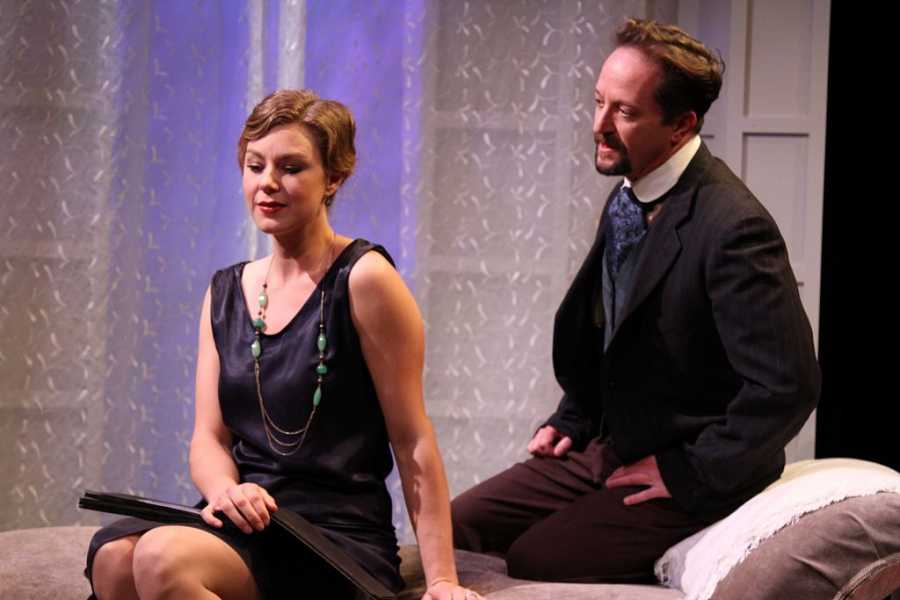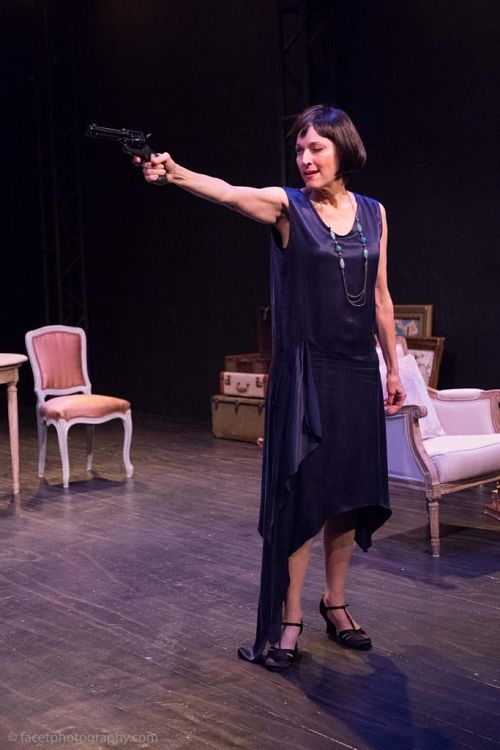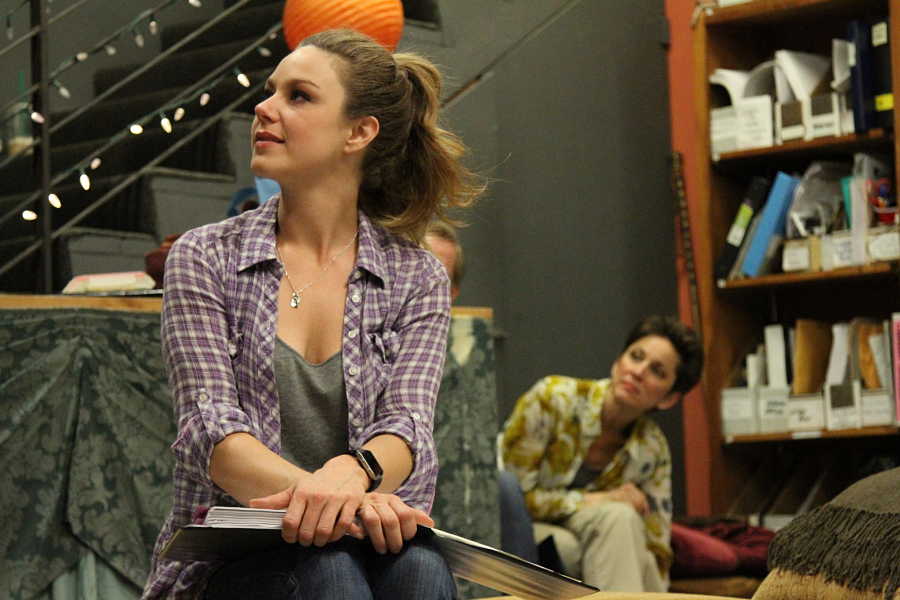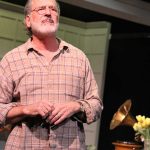It’s a typical first read for the Antaeus Theatre Company. The long, non-matching tables form a squared-off U. Distributed atop them are conveniently located pump bottles of hand sanitizer and handfuls of freshly sharpened pencils standing in coffee mugs. At even intervals around the U are place-settings delineated by standup name cards: Berte, Aunt Julle, Judge Brack, etc., and—at the center of it all—Hedda Gabler.
Behind each name card: two chairs.
For this show is partner cast. Two actors per role has been part of Antaeus’s culture since its 1991 founding. There are seven roles in Andrew Upton’s 2004 adaptation of Ibsen’s classic. And so tonight 12 actors will arrive at the theatre as the reading begins.
Twelve actors for seven roles? Shouldn’t there be 14? This demonstrates precisely the reason for partner casting in the first place. Many actors are drawn to Los Angeles for its film and television industry, not stage work. When scaled by hours worked, nearly all filmed performances, no matter how minor, pay better than nearly all staged performances, no matter how major. Nevertheless, many actors yearn for their craft’s natural medium, the theatre, where there is a sequential, continuous emotional arc and a live audience’s energy.
In theatre, the show must go on even when the actor cannot—an iron mandate that can be especially tested in Los Angeles, where screen work, or the promise of it, can pop up at any time. And when it pops up, whether during rehearsal or the show’s run, it creates make-or-break opportunities that must be dealt with immediately.
For Antaeus, a theatre company that specializes in classics, the burden can be greater still. Classic plays—a broad definition that encompasses everything from William Shakespeare and Tennessee Williams to Caryl Churchill and Bertolt Brecht—often involve larger casts and challenging language not in the modern vernacular. The artistic demands of such works require professional interpretations and productions. How to create the required ensemble of highly skilled artists that is stable amid the modern actor’s fluid employment reality?
Antaeus’s solution: Cast two actors for each role. The process is called partner casting rather than “double casting” to emphasize that, ideally, the two actors share in the development of their character. This shared character development combines naturally with those of the other actor-pairs into a shared collective vision of the show. The production’s artistic evolution and integrity are therefore fortified against individual absences.
And so the first table read of Hedda Gabler proceeds smoothly despite two missing actor partners. By the time performances begin in 10 weeks, however, partner casting will ensure that seven actors thoroughly involved in the artistic development of the production will be onstage each night.
While partner casting solves a critical problem for the theatre company, what are the consequences for audiences? Since skilled actors can now commit to a long-term production without fear of losing more lucrative short-term work, partner casting allows audiences to see a higher-caliber actor in every role, no matter how minor. Audiences who turned up for Antaeus’s 2010 production of King Lear, for instance, would see either Dakin Matthews or Harry Groener—both highly lauded actors of screen and stage—in the title role.
But the practice doesn’t sit well with everyone: L.A. Times critic Charles McNulty (who saw both Lears) wrote that “the performers would have benefited from more concentrated rehearsal time,” blaming this deficit on the partner casting. Five years later, he was still tweeting his disapproval: “If you’re going to do ‘King Lear,’ for crying out loud, stick to a single cast!”
Of course, it’s counterfactual to imply that a single-cast production would be superior to a partner-cast one, since the single-cast performance doesn’t exist for comparison. It does beg the question, though: What are the special artistic requirements and aesthetics associated with partner casting?
To answer that question, I’m exploring partner casting from the inside. I have spoken extensively with many theatre artists around Los Angeles, and I’ve received permission from Antaeus to follow its process intimately for its production of Hedda Gabler, which runs May 26-July 17.
My initial experience with the cast is at the first table read. I’m not surprised by the wide variability in physicality within each pair; Antaeus partner pairings have always been blind to issues of age, height, skin tone, and even gender. Casting is based on artistic essence, not substitutional similarity. Director Steve Robman, a highly accomplished veteran of both stage and television, is intrigued that partner casting has allowed him to simply choose his top two picks for each role rather than agonizingly rank them, as is usually required.
This first read is indicative of what the next eight weeks of rehearsal will be like, before the cast will be split in two. Robman asks one actor in each pair to read for Act I. The other actor in each pair is then brought in for Act II, and for the rest of the evening different actors of each pair will switch in and out. The actors themselves are eager to work with as many different cast combinations as possible. They mix things up far better than either the director or stage manager can.
For now, both actors in a pair are present whenever their character is involved in a scene. How partners work within their pairing varies as much as the actors themselves. Although a few actors have discussions outside rehearsal, most find the time within the theatre—including offstage breaks—to be sufficient in exploring their shared roles. Some pairs are so tight that they begin to unconsciously mirror each other when discussing points with the director.
Many of the actors in Antaeus productions find value in partner casting. In particular, the process forces them to abandon the notion that a role is “theirs,” and reminds them that their work is in service to the story, not the other way around. When watching their counterpart onstage, an actor can witness their character in the context of the story, just as the audience will. And, of course, having a partner provides a second set of ideas and perspectives for rummaging.
But not all actors enjoy the process artistically. Occasionally there is a personality mismatch in a pair, as in an awkward arranged marriage. Others express frustration that developing a role this way requires a sort of constant negotiation with an actor-partner, which is nothing like the usual discussion with a director. Still others prefer to minimize discussions with their partner, and instead simply set about building their character out of the common pieces presented. When asked why they choose to work in an artistic environment that might not be optimal for their personal process, the answer is always the same: “How else to work on classic plays with actors of Antaeus caliber?”
Regardless of how an actor feels about partner casting, however, all are grateful for it when they need it to temporarily disappear from a production. Individual actors may be absent for as much as a week at a time, or more—as when an actor in Hedda Gabler finds a well-paying LORT job at South Coast Repertory and rehearsals continue unabated. It falls to stage manager Kristin Weber to work out the complex scheduling logistics to maximize each actor’s rehearsal time with the group.
But it’s not a revolving door. Antaeus is strict about what constitutes a legitimate absence: in short, another work opportunity. As co-artistic director Rob Nagle explains, “Partner casting is not like covering a shift in a restaurant.” Instead it’s a fully collaborative effort. Antaeus actors aren’t understudies or alternates, simply subbing in and recreating individual roles developed by others. The company process demands that all partners actively contribute to both their own role’s development and to the shared artistic endeavor of the production as a whole.

Just before tech begins, at week 8, the ensemble splits into two casts. This can cause anxiety among some of the actors, who may have preferences about with whom they wish to work. It is likely, however, that the preference is an acknowledgement of some chemistry already obvious to the director.
Hedda Gabler’s two casts are referred to as “The Pistols” and “The Generals,” names associated with the play that indicate no hierarchy between them. These casts are the home bases that will define the rest of the production process. After watching the group rehearse for eight weeks, I’m not surprised at the way Robman chooses to divide the actors. His are logical choices, centering around core subgroups that have emerged naturally over the preceding rehearsals.
If an actor isn’t happy with their final grouping? “It may be the actor is clinging to something internal—making the experience precious,” says co-artistic director John Sloan. “Partner casting is about accepting the artistic possibilities.”
Possibilities indeed: Every Thursday and Friday performance forms its cast by randomly selecting an actor from each pair. Antaeus has found that this mixed-casting practice keeps the overall feel of the production taut among the actors in the two casts. It’s also an artistic reminder of the shared vision that was created before the subgroups were formed.
Nevertheless, I note an obvious change in ensemble behavior after the split occurs. Where previously rehearsals revolved around the role pairings, now the actors are suddenly possessive about the members of their respective “teams,” referring to “my Hedda” or “my Tesman.” And while the mixed-cast nights can create exciting moments for the actors, they enjoy returning to their familiar home team.
It is curious to consider that, after tech week, an actor won’t see their partner inside the theatre again. The mixed casts ensure that you’ll interact with every other actor in the company until the production’s end except your partner. The split, then, represents a sudden and permanent “farewell” to the actor who, moments before, was the cast member most closely linked to you.

The last performances I see are five weeks after opening night—a full 15 weeks since the first table read. Even after all the read-throughs, tech runs, previews, and opening nights (both of them), I find the play and performances engaging. As with any show later in its run, the home team cast has settled in and hit its stride. There is a sophisticated lightness of touch to this interpretation of Ibsen, and this particular show deftly and intentionally draws loud audience laughter only seconds before the play’s tragic end.
Partner casting has allowed many in the cast of Hedda Gabler to pursue job opportunities during production. However, the path an artist follows to attain their vision matters only to the artist, not to their audience. A play can only be judged by what’s onstage, not how it arrived there. After 15 weeks of immersion with this production, I can’t imagine a better end result than what I see in the final week, regardless of the path it took to get there. But the particular path chosen here, partner casting, proved fulfilling for both audiences and actors.
I sit with co-artistic director Bill Brochtrup in the Antaeus lobby, surrounded by framed photographs of past shows, two per production. He pauses in his explanation to me about the value of partner casting. His eyes have caught the pair of King Lear photos from 2010, one with Dakin Matthews, the other Harry Groener.
“It would make me sad to lose one of the versions of each play,” Brochtrup says. “How sad would it be to lose half of those moments?”
I wish to thank the Antaeus Theatre Company for permitting me full access to its production of Hedda Gabler, especially director Steve Robman, stage manager Kristin Weber, and company manager Robin Campbell.
Kevin Delin is a Los Angeles-based writer and scientist. You can follow him on Twitter at @kdelin.










